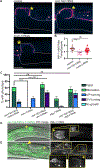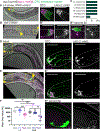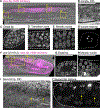The Rac pathway prevents cell fragmentation in a nonprotrusively migrating leader cell during C. elegans gonad organogenesis
- PMID: 38776905
- PMCID: PMC12013728
- DOI: 10.1016/j.cub.2024.04.073
The Rac pathway prevents cell fragmentation in a nonprotrusively migrating leader cell during C. elegans gonad organogenesis
Abstract
The C. elegans hermaphrodite distal tip cell (DTC) leads gonadogenesis. Loss-of-function mutations in a C. elegans ortholog of the Rac1 GTPase (ced-10) and its GEF complex (ced-5/DOCK180, ced-2/CrkII, ced-12/ELMO) cause gonad migration defects related to directional sensing; we discovered an additional defect class of gonad bifurcation in these mutants. Using genetic approaches, tissue-specific and whole-body RNAi, and in vivo imaging of endogenously tagged proteins and marked cells, we find that loss of Rac1 or its regulators causes the DTC to fragment as it migrates. Both products of fragmentation-the now-smaller DTC and the membranous patch of cellular material-localize important stem cell niche signaling (LAG-2 ligand) and migration (INA-1/integrin subunit alpha) factors to their membranes, but only one retains the DTC nucleus and therefore the ability to maintain gene expression over time. The enucleate patch can lead a bifurcating branch off the gonad arm that grows through germ cell proliferation. Germ cells in this branch differentiate as the patch loses LAG-2 expression. While the nucleus is surprisingly dispensable for aspects of leader cell function, it is required for stem cell niche activity long term. Prior work found that Rac1-/-;Rac2-/- mouse erythrocytes fragment; in this context, our new findings support the conclusion that maintaining a cohesive but deformable cell is a conserved function of this important cytoskeletal regulator.
Keywords: GTPase; Rac; fragmentation; germline; gonad; leader cell; migration; stem cell niche.
Copyright © 2024 Elsevier Inc. All rights reserved.
Conflict of interest statement
Declaration of interests The authors declare no competing interests.
Figures






Update of
-
Getting there in one piece: The Rac pathway prevents cell fragmentation in a nonprotrusively migrating leader cell during organogenesis.bioRxiv [Preprint]. 2023 Dec 4:2023.12.01.569642. doi: 10.1101/2023.12.01.569642. bioRxiv. 2023. Update in: Curr Biol. 2024 Jun 3;34(11):2387-2402.e5. doi: 10.1016/j.cub.2024.04.073. PMID: 38106045 Free PMC article. Updated. Preprint.
Similar articles
-
Getting there in one piece: The Rac pathway prevents cell fragmentation in a nonprotrusively migrating leader cell during organogenesis.bioRxiv [Preprint]. 2023 Dec 4:2023.12.01.569642. doi: 10.1101/2023.12.01.569642. bioRxiv. 2023. Update in: Curr Biol. 2024 Jun 3;34(11):2387-2402.e5. doi: 10.1016/j.cub.2024.04.073. PMID: 38106045 Free PMC article. Updated. Preprint.
-
Active nuclear positioning and actomyosin contractility maintain leader cell integrity during gonadogenesis.Curr Biol. 2024 Jun 3;34(11):2373-2386.e5. doi: 10.1016/j.cub.2024.03.049. Epub 2024 May 21. Curr Biol. 2024. PMID: 38776903
-
Ribosomal protein mutation suppresses gonadal leader cell migration defects in mig-17/ADAMTS mutants in Caenorhabditis elegans.Sci Rep. 2025 Jul 21;15(1):26435. doi: 10.1038/s41598-025-10316-3. Sci Rep. 2025. PMID: 40691188 Free PMC article.
-
Relationship between Pituitary Gland and Stem Cell in the Aspect of Hormone Production and Disease Prevention: A Narrative Review.Endocr Metab Immune Disord Drug Targets. 2025;25(7):509-526. doi: 10.2174/0118715303314551241031093717. Endocr Metab Immune Disord Drug Targets. 2025. PMID: 39812047 Review.
-
Inhaled mannitol for cystic fibrosis.Cochrane Database Syst Rev. 2018 Feb 9;2(2):CD008649. doi: 10.1002/14651858.CD008649.pub3. Cochrane Database Syst Rev. 2018. Update in: Cochrane Database Syst Rev. 2020 May 1;5:CD008649. doi: 10.1002/14651858.CD008649.pub4. PMID: 29424930 Free PMC article. Updated.
Cited by
-
Pre-dauer starvation decouples somatic from germline development with lifelong reproductive consequences in C. elegans.bioRxiv [Preprint]. 2025 May 28:2025.05.23.655783. doi: 10.1101/2025.05.23.655783. bioRxiv. 2025. PMID: 40502126 Free PMC article. Preprint.
-
Microglia efferocytosis: an emerging mechanism for the resolution of neuroinflammation in Alzheimer's disease.J Neuroinflammation. 2025 Mar 30;22(1):96. doi: 10.1186/s12974-025-03428-0. J Neuroinflammation. 2025. PMID: 40159486 Free PMC article. Review.
-
MIG-21 is a novel regulator of Wnt and Netrin signaling in gonad migration identified from published scRNA-seq data and functionally validated in C. elegans.bioRxiv [Preprint]. 2025 Feb 25:2025.02.24.639896. doi: 10.1101/2025.02.24.639896. bioRxiv. 2025. PMID: 40060509 Free PMC article. Preprint.
-
FLYWCH transcription factors act in a LIN-42/Period autoregulatory loop during gonad migration in C. elegans.bioRxiv [Preprint]. 2025 Jul 11:2025.07.10.664215. doi: 10.1101/2025.07.10.664215. bioRxiv. 2025. PMID: 40672334 Free PMC article. Preprint.
-
An RNAi screen of Rab GTPase genes in Caenorhabditis elegans reveals that morphogenesis has a higher demand than stem cell niche maintenance for rab-1 in the somatic cells of the reproductive system.G3 (Bethesda). 2025 Jun 4;15(6):jkaf085. doi: 10.1093/g3journal/jkaf085. G3 (Bethesda). 2025. PMID: 40239019 Free PMC article.
References
Publication types
MeSH terms
Substances
Grants and funding
LinkOut - more resources
Full Text Sources
Research Materials
Miscellaneous

